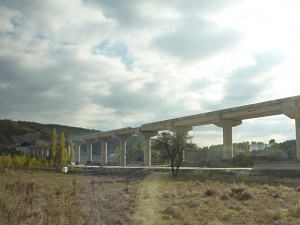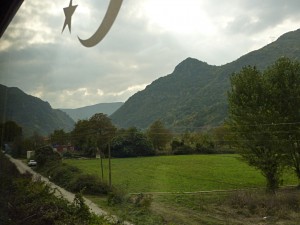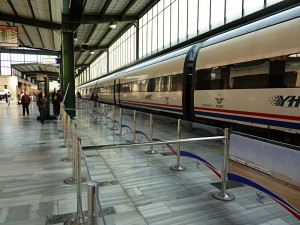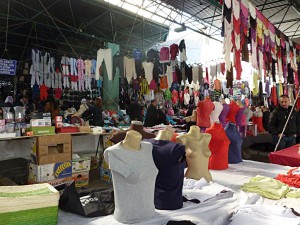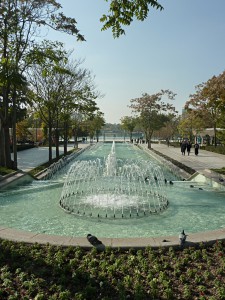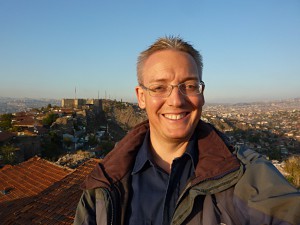On Sunday, I took the train from Istanbul to the Turkish capital, to Ankara. Not a dream destination for tourists, the city is a good stop to cut bus and train journeys short to experience Turkish city life. Besides, I had other reasons to visit the second largest city in Turkey.
Whenever I plan enough time to get to a departure point of trains and buses, I end up at the station way too early. Sunday was to be no exception in that respect. Using the tram and the boat, I had to get to the Haydarpasa train station in Istanbul. The boat circulates every 20 minutes, the frequency of the trams is still unknown to me. Including the travel times, the walk to the tram stop and some time to buy the train ticket, I ended up being exactly one hour too early at the train station. The hour was spent watching a promotion video for the ongoing construction of the Turkish high-speed rail system a few times.
Like many European countries, Turkey is building a high-speed rail system to connect East and West as well as North and South of the country. I had the chance on Sunday to experience on section, which is already finished. On another section I saw many construction sites. The distance of more than 500 kilometers currently takes 6 hours by train, not exactly what I would call a high-speed train. The first four hours, in which the train managed about half the distance, led along the coast of the Marmaris sea to Izmit, before turning South across the mountains to Eskisehir. This stretch consists of many kilometers of a single track. The second stage of the high-speed rail system, includes a replacement of this track by building dozens of tunnels and bridges, instead of running along the river as it currently does. When seeing and reading about the tunnels and bridges, one is immediately reminded of the ICE track in Germany between Cologne and Frankfurt. Additionally a lot of terrain is moved, such that hills are divided in two and hillsides are completely removed.
Once in Eskisehir, one has to change trains to get up to speed. The business class seat I had to buy, definitely showed why Turkey is up to level with other European countries: three rows of seats including a personal entertainment system and a snack and drinks were included. At 250 km/h there is little time to enjoy the grassland outside. In 90 minutes the train manages the second half of the distance with only one intermediate stop in Sincan.
On interesting fact though: there were 26 minutes to make the connection in Eskisehir. I wonder how the train schedules work, when one has to have that much buffer. On the other hand, having that much buffer guarantees that the connection works and considering that all luggage for the high-speed train has to be x-rayed, it might even make sense…
In Ankara I had two goals: on the one hand, I wanted to get my visa for Turkmenistan, having received the necessary letter of invitation two weeks ago per e-mail. On the other hand, I wanted to discover the Turkish capital, which after all sports a few tourist attractions.
The Turkem embassy is opened on 4 days a week from 9am to 12am. Since it isn’t very centrally located, I took a taxi to get there. Even the taxi driver had to ask a colleague in that part of the city, where the embassy was exactly located. I had asked at the reception desk of my hotel, how much the taxi ride should cost. The answer was somewhere between 15 and 17 lira. I was quite surprise when the meter showed 16.38 lira, when the driver pulled up in front of the embassy. Good guess!
I had arrived just after 10am, such that I should have been able to proceed to the visa section of the embassy immediately. However, the gate was locked. I rang the bell and a few minutes later, a voice asked in Turkish, what I wanted. I just said, that I was here for a visa, which the person at the other end did not understand. Then I asked whether he spoke English, for which I got the answer: “No English!”. Fortunately, the police man at the gate knew some English, so he transferred my reason for being there to the person at the embassy. However, the gate remained closed.
As time passed, more and more people with loads of passports in their hands showed up, all of them in need of visas (mostly for truck drivers, passing through Turkmenistan). Just before 11 o’clock, the gate finally opened and the first one to arrive after me ran into the office, to be the first one to get his visas. Nice move! I followed him and when it was my turn, the guy at the counter asked how long I was staying in Ankara. I told him that I intended to leave the next day. He took a closer look at my letter of invitation and informed me, that I could get a visa at the Howdan border check point. I asked him, how long it would take to get the visa in Ankara, which he answered by grabbing his calender and pointing at November 3. Since I didn’t want to stay that long in Ankara, I left the embassy without the visa.
I decided to walk the 6 kilometers back to the old town, because I like to discover cities by just wandering around. On my way, I passed condos, shopping streets, a bazaar and finally I ended up in Genclik park. This recreational park in central Ankara is a lovely place for sitting down and rest for while, or even going on an amusement ride. For me, the park was a reason to stop and eat a light lunch before continuing my endeavors to the train and bus stations.
What followed was a lesson in communication by hands and feet. I absolutely understand that not everyone speaks a foreign language, there is nothing wrong with that fact. But in this regards, the Turkish people definitively made a negative impression on me. Although they are very helpful, it is very hard to find a person who speaks a foreign language. Not even the lady at the information desk at the main train station was able to speak any foreign language.
After my lunch, I asked the owner of the bistro, how I could get to the bus station. I understood the words metro and otogar (bus station). Sure thing, I thought, just find the metro station, take a look at the metro lines and you will find out how to get there. Unfortunately, you only have access to the map, if you have a ticket, but how do you know what kind of ticket to buy, if you don’t know which stop you are going to?
I bought a single ride ticket and boarded the metro, hoping that I got out on the better end of my 50:50 chance of taking the metro line in the correct direction. On the train, I asked the next person, how to get to the otogar, but his 5 words in Turkish were just to fast for me to pick up and then he immediately had to get of the train. I got off at the following stop, knowing it was the one, where the two metro lines intersect. Fortune was again on my side, since two young ladies had followed my interrogation of the one passenger and one of the decided, she help me by showing where my connecting train would leave. In this manner, I eventually arrived at the bus station, where I bought a ticket to Göreme for the next morning before heading back to the train station.
Once in the train station, my seemingly simple question was when the trains leave Van in Eastern Turkey for Teheran. Since the lady at the information desk did not speak any foreign languages, I was stuck. Help came in form of a Turkish man standing next to me who had grown up in Germany and who is a certified translator for Turkish and German. We criss-crossed through the train station until we ended up in some official looking person’s office. The answer I got was: on Tuesdays at 8pm there is a train from Van to Teheran. He did not mention one of the trains passing through Van, like the Trans-Asia Express from Ankara to Teheran. Anyway, the information was still very valuable for me, since Tuesday suits me perfectly, since I plan to take that train on November 8.
I continued my stroll to the ethnographic museum, which is closed on Mondays, through the old town and its shopping streets to the citadel. It was amazing how the sounds of the busy street just below the old town disappear, once one enters the shopping streets with all the clothes hanging about for sale.
On my way to the citadel, I could be a real tourist again: the streets are lined with souvenir shops and ladies were selling the handmade goods. Occasionally there seems to be a foreign tourist, since the ladies knew a few words of English: “Mister, ten lira!”
Once I arrived at the citadel, I had the whole ruin for myself. Remembering Jungfraujoch (Top of Europe), I would call the place Top of Ankara. The view across the city is breathtaking! Since the sun was already setting, the whole city was glowing in red. That the citadel is a great place to enjoy a sunset is known to many locals, who suddenly appeared from below.
On the way back to the hotel, I was looking for a restaurant, which offered other Turkish food than grilled meat and after dinner continued with my search, but this time for a bakery which offered baklava.
Walking the streets of Ankara during rush hour compares well to the car parades which grew so popular in the past years during soccer championships. Just the motivation for honking is a different one. To me it seems again a bit schizophrenic: Turkish drivers either hinder traffic, by going very slow, or are in such a hurry, that they are very pushy and honking all the time. The Turkish way of driving reminds me of the Ecuadorian way of driving in the year 2000: go as you like and if somebody thinks you have to yield, they’ll honk…

